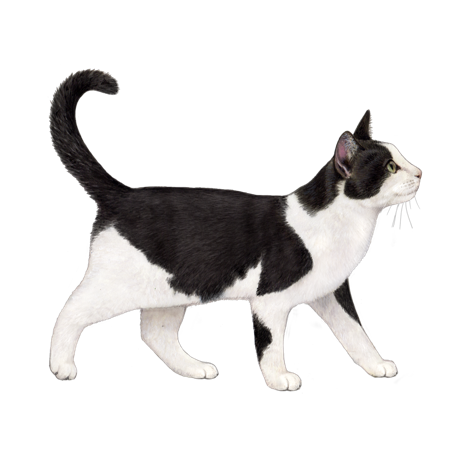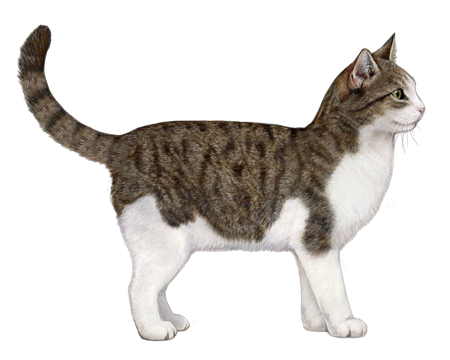
American Shorthair
American Shorthairs make excellent all-around pets. They're playful, intelligent, sweet-natured cats that fit right into any family. And if you have a mouse problem you'd like taken care of, the American has you covered.
Interested in discovering if your cat is an American Shorthair?
Check out Wisdom Panel's DNA test.
American Shorthair Traits
General Appearance
The American Shorthair is a medium-sized, strong breed. These well-balanced and symmetrical cats have a body type that suggests power and agility.
Coat and Colouring
As you might imagine, American Shorthairs have short, hard-textured coats. The coat's thickness can vary based on region and season but is always dense enough to provide some protection from moisture and cold.
The American's coat comes in more than 80 different colors and patterns—including silver tabby, bi-color, calico, and tortoiseshell.
Distinctive Physical Traits
The American has a large head and a full-cheeked face with a sweet expression. Their eyes are large and alert, with upper lids shaped like half almonds. A strong neck, well-developed chest, and muscular legs add to their overall athletic appearance. Their tails are medium-long and thick at the base, tapering to a blunt end.
American Shorthair Temperament
American Shorthairs are a playful, adaptable breed well suited to everything from quiet apartments to busy households. They're typically patient with kids and get along with dogs and other pets, making them an excellent breed for families.
In general, Americans are independent cats that can keep themselves entertained. They enjoy following their humans from room to room but aren't too demanding of their attention. Though males and females are both good-natured, the guys tend to be the most easygoing.
True to their working cat backgrounds, Americans are hardy, athletic cats. Since their hunting instincts remain strong, they do their part to keep the house free of rodents and insects.
American Shorthair History
American Shorthairs made a name for themselves as hardy, working-class cats. They accompanied settlers traveling from Europe to North America and were responsible for hunting rats on the ships. Historical records show that some of these cats even set sail on the Mayflower in 1620.
Pioneers instantly adored American Shorthairs for their hunting prowess. But it wasn't until the late 19th century that people started to appreciate their beautiful and varied coats. Around this time, breeders decided to develop and show a shorthair that looked like the working cats that had been in North American for centuries. The Cat Fancier Association (CFA) recognized the breed (then known as the Domestic Shorthair) as one of its inaugural breeds in 1906.
Breeders then used the best specimens of the widely varied Domestic Shorthair to develop a breed with a specific set of traits. The CFA changed the breed name to American Shorthair in 1966—distinguishing these purebred cats from the many random-bred cats found on the streets.
Today, the American Shorthair is among the most popular cat breeds.
American Shorthair Care
Nutrition
American Shorthairs require a high-quality diet. Because nutritional needs vary for kittens, adults, and senior cats, be sure to choose an age-appropriate formula.
To help your cat maintain a healthy body weight, monitor food intake and reduce their portions if they start to gain extra pounds. Also, keep an eye on the number of treats you give them. Calories can add up fast for cats of this size. As a guideline, treats should make up no more than 10% of their daily calories.
In addition to their daily meals, ensure your cat has access to fresh, clean water at all times.
Grooming
American Shorthairs are excellent self-groomers. Still, their thick coats need weekly brushing to look their best. Regular nail clipping is also required, as nails that get too long are more likely to snag on something and become torn or damaged. Overgrown nails may also grow into your cat's paw pads, leading to pain or infection. A scratching post can help keep their nails in good shape and satisfy their instinct to scratch.
Dental hygiene is an essential part of every cat's overall care. Start your American on a dental routine that includes at-home teeth brushing and professional exams and cleanings.
Health
Roughly one out of every three cats in the United States is overweight or obese. And those extra pounds can contribute to other health risks—such as arthritis, diabetes, and heart problems. Ask your veterinarian about tips for keeping your cat at a healthy weight.
American Shorthair Genetic Health Conditions
-
Burmese Head Defect (Discovered in the Burmese)
Burmese Head Defect causes severe facial defects when two copies of the variant are present, and affected cats require humane euthanasia shortly after birth.
-
Polycystic Kidney Disease (PKD)
Polycystic Kidney Disease (PKD) is the most common inherited disease in cats. The disease causes the formation of fluid-filled cysts in the kidneys that can lead to kidney failure.
With more than 45 health tests, Wisdom Panel™ Complete for Cats screens for these and other important genetic conditions—allowing you to better plan for your cat's lifelong care.
Breed Group
Western
The largest of breed groups, the Western Group is mainly comprised of cats developed in Europe and the Americas. Due to the complexity of feline genetic diversity, however, cat breeds from other regions may also be found associated with this group.
Resources
https://cfa.org/american-shorthair/
https://www.tica.org/breeds/browse-all-breeds?view=article&id=820:american-shorthair-breed&catid=79
https://cfa.org/wp-content/uploads/2019/06/american-shorthair-standard.pdf
https://vcahospitals.com/know-your-pet/cat-breeds/american-shorthair
https://www.banfield.com/state-of-pet-health/obesity
Reviewed 23 February 2021 by Annette Louviere, DVM




































